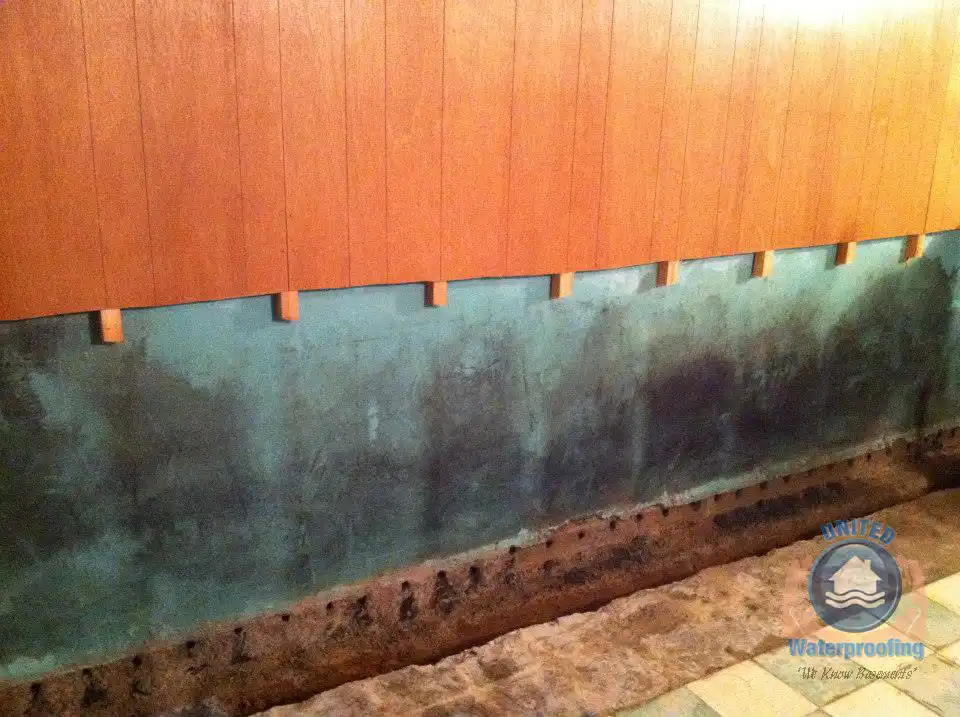A wet basement can be a nightmare for homeowners, causing water damage, mold growth, and compromising the structural integrity of your home.
Basement waterproofing is the best solution to insulate your home from these risks and help you protect your finished basement.
There are several types of basement waterproofing products, including interior and exterior, each with unique advantages and disadvantages.
In this blog post, we’ll explore the different types of basement waterproofing systems and help you decide which one is right for your home.

Interior basement waterproofing is a popular and cost-effective way to manage water that enters your home from the inside.
Instead of blocking water before it reaches the foundation, this system is designed to capture and redirect water that seeps in through walls, floors, or the cove joint where the wall meets the floor.
It typically involves installing a drainage channel along the interior perimeter of the basement, just beneath the floor slab, which then carries water to a sump pump for removal.
This method requires no exterior excavation, making it far less invasive and more affordable than exterior options.
While most interior waterproofing systems rely on a sump pump system, there are several types of interior drainage products that will help waterproof your basement.
The sump pump is the most critical part of an interior waterproofing system. Installed in a sump pit at the basement’s lowest point, it collects water from the interior drainage system and pumps it outside, away from your foundation.
Most systems operate automatically and can be fitted with a battery backup to ensure functionality during power outages. A working sump pump prevents flooding and is essential in any home where water intrusion is a concern.
Floor drains are installed in the basement slab to remove surface water caused by spills, appliance leaks, or minor seepage. These drains connect to the interior drainage system or directly to the sump pit, allowing water to be efficiently routed out of the home.
While not a standalone solution, floor drains add valuable protection for utility areas such as laundry rooms, basements with boilers or water heaters, and finished lower levels.
An interior footing drain, often called a drain tile system, is installed along the inside edge of the foundation footing, beneath the basement floor. The system uses a perforated pipe surrounded by gravel to collect groundwater that seeps in through foundation joints or porous walls.
Water is then directed to the sump pump for removal. This type of drainage system relieves pressure from the foundation walls and floor, making it one of the most effective solutions for preventing water buildup in the basement.
Exterior basement waterproofing is another popular method of keeping your basement dry. This method involves excavating the soil around your home’s foundation and applying a waterproof coating to the exterior walls.
It also involves installing an exterior drainage system that directs water away from your foundation.
To get a better look at how exterior drainage systems work, let’s explore different products to see how they direct water away from your foundation and basement walls.
A French drain is an exterior basement waterproofing system that involves digging a trench around the perimeter of your home and installing a drainage system. This system collects water and redirects it away from your foundation, preventing water from seeping into your basement.
A vapor barrier is a waterproof membrane that is installed on the interior walls and floor of your basement. This system prevents moisture from entering your basement and causing water damage.
It is a cost-effective option for homeowners who do not want to undertake a major waterproofing project.
Choosing the right waterproofing system in New Jersey depends on a variety of factors, including:
A professional evaluation is the best way to determine which system is best suited to protect your home from water intrusion.
Basement waterproofing is an essential home improvement project that can help protect your home from water damage and mold growth.
The right waterproofing system for your home depends on several factors, including the age of your home, the type of foundation, and the soil conditions around your home.
By consulting with a professional basement waterproofing contractor like United Waterproofing, you can determine which type of basement waterproofing system is right for your home.
Contact us today to schedule a consultation and learn how we can help protect your home from water damage and moisture.
When installed professionally, most systems can last 20+ years. Frequent maintenance to check for clogs and other deficiencies can greatly extend the life of your system.
No. Waterproof paint can block vapor, but it won’t stop active leaks or water pressure. It’s best used as part of a larger waterproofing system.
Costs vary depending on the system type and the extent of the work. Interior systems are generally more affordable, while exterior excavation is more labor-intensive. We offer free consultations to provide accurate estimates.